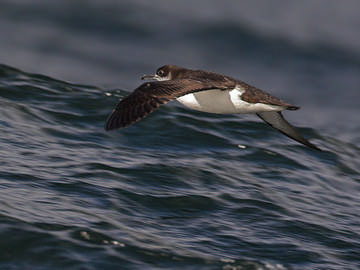Manx Shearwater (Puffinus puffinus)

Manx Shearwater © Steve Round
A Manx Shearwater within sight of the Wirral coast in winter is in the wrong place, in location and habitat: in that season, most of them are in the southern hemisphere and way offshore beyond the continental shelf (BWP, Migration Atlas). All of those recorded during this Atlas were on 21 November 2006 or 9 December 2006, the two days during which an unusual combination of winds also brought record numbers of winter Leach’s Petrels to our coast.
The normal status of Manx Shearwater in Cheshire and Wirral is as a coastal visitor, most often seen during strong onshore winds from April to September, with largest numbers from June to August. These are adult birds, away finding food from their nests in burrows on offshore islands. About 80% of the world population nests in the British Isles. Our nearest colonies are at Copeland, Northern Ireland (nearly 5,000 pairs), and Bardsey Island, Gwynedd (16,000 pairs), but it would only be a relatively short flight for a bird from the largest Welsh colonies, 102,000 pairs on Skomer and 46,000 pairs on neighbouring Skokholm in Dyfed (Mitchell et al 2004). Despite the species’ name, only 34 pairs nest on the Calf of Man. Those from the world’s largest colony, the 120,000 pairs on Rum off the Scottish west coast, normally head west to forage off the Atlantic shelf. The two parents take it in turns to keep the single egg warm throughout their seven-week incubation period, and in bringing food to the chick during the ten weeks before it fledges. They may well be away for several days at a time, some Skokholm birds being known to fish for sardines in the Bay of Biscay up to 1,000 km from their nest. When the chick fledges in September, the adults and juveniles leave and fly rapidly, perhaps covering 750 km a day, to winter in the Atlantic off South America. But, crucially for their position in this Atlas, small numbers stay in the Bay of Biscay (Migration Atlas).
These few Manx Shearwaters thus share similar wintering quarters to some of the Leach’s Petrel population, and were presumably caught up in the same pattern of winds from mid-November 2006, when gale-force south-westerly winds apparently blew some birds back north from their wintering areas into the Irish Sea. When the winds changed to northwesterly the seabirds were driven within sight of observers on land, first on 21 November 2006 when one Manx Shearwater was seen off Hilbre Island and later on 9 December when the species was reported from a further five tetrads. No more than one bird was seen at any one time but it is impossible to tell how many were present on that remarkable day. One observer, Colin Jones, reported a Manx Shearwater from three different tetrads off the middle of the north Wirral coast (SJ29F, G and R) and, from the times and places of observation and the movement of the birds, believes that they were three different birds. The records at the ends of the north Wirral, Hoylake shore (SJ29A) and the bird seen flying out of the Mersey at New Brighton (SJ39C), could have been different again, making a total of anything from one disoriented individual to a maximum of five birds.
The extraordinary nature of these records is illustrated by reference to the ornithological literature. Coward (1910) knew of no winter birds, but later had the good fortune to see a party of seven near the Liverpool Bar lightship on 30 January 1931 (White et al 2008). Hardy (1941) used the throwaway line ‘occasionally at Mersey and Dee mouths in autumn and winter’ but without any detail it is impossible to know what support there was for that statement. A bird off Hilbre on 28 November 1984 appears to be the only Manx Shearwater ever seen from land in Cheshire and Wirral prior to those in 2006.
Looking outside the county, there was only one record of the species in England (off Filey, Yorkshire) during the winters 1981/ 82 to 1983/ 84, with two sightings in Wales, groups of one and five off Anglesey (BTO Winter Atlas). The Birds of Lancashire and North Merseyside contains the statement that ‘it is doubtful if any Manx Shearwater has ever occurred in Lancashire in a healthy state during winter’ (White et al 2008). The state of health of those seen in late 2006 is not known, but none was known to have been found sick or dead.
Sponsored by Noel and Hilary Woodhead

